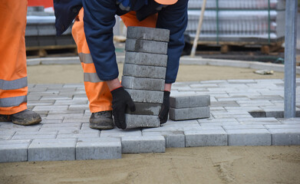Concrete repair can be a difficult task. It requires an evaluation of the structure, a determination of causes of the deterioration or distress, destructive and nondestructive inspection, laboratory testing (including chemical and petrographic analysis), and selection of repair methods and materials.
Concrete Repair Colorado Springs properly prepares for a good bond with the repair material. Bond strength is also important.

Concrete is a highly durable construction material that provides long-term service when poured and finished correctly. However, all concrete has a shelf life and is subject to wear, tear, and weathering that can reduce its longevity and result in cracks. Thankfully, many concrete repair methods can be used to address these issues. Some of the most common include routing and sealing, patching, and stitching. Each of these techniques can be successfully applied to various types of cracked concrete, but it is important to choose the best method for the job.
Typically, a chemically reactive polyurethane resin is injected into the crack to seal wet or leaking cracks. This is a quick, cost-effective method that can be used on both active and dormant cracks. The cured resin chases the water and penetrates into tight micro-cracks and pores to form a firm bond to wet concrete. This is a permanent repair that is very effective on wet cracks and will tolerate future movement in the crack.
The rout-and-seal method involves grinding a channel through the centre of the crack, and then filling it with sealant. Field workers must thoroughly clear out all debris, leaves, sticks, and other obstructive materials that could interfere with the process or inadvertently contaminate the routed channel. Routing is a more expensive option than clean-and-seal, but it offers superior results in the long run, including reduced crack recurrence and a higher overall service life.
Stitching is another permanent concrete repair technique that consists of drilling holes along the length of a crack and grouting them. This method creates a “key” that locks the crack and prevents further movement in adjacent concrete sections. The key also helps reduce leakage and prevents the loss of soil from around the crack.
Stitching may be used in conjunction with other repair methods, such as clean-and-seal or rout-and-seal, to extend the life of the repaired crack. However, this method is not suitable for all conditions, as it may increase the structural restraint on a section of the structure and induce further cracking elsewhere.
Concrete cracks by nature, and it isn’t uncommon for concrete in areas with a lot of foot traffic or exposure to the elements to break down over time. While cracks are inevitable, properly installed concrete patching can prevent further deterioration.
To repair a crack, you must first clean out the damaged area. Whether this is done by hand, with a jackhammer or with an HPWJ machine the area needs to be free of any loose material like concrete chips dust, debris, and oil stains. The area will also need to be brushed or scraped to create a clean surface for bonding. The crack will need to be chiseled down to a symmetrical inverted V shape in order for the new patching material to adhere. The bottom of the crack should be wider than the top to prevent moisture from getting in and causing future problems.
Once the cracked area is cleaned it’s important to remove any rust or corrosion from the exposed steel reinforcing bars, if applicable. This can be accomplished with a wire brush or a broom. This will help ensure that the patching material bonds well to the underlying steel and that any future cracks won’t form within the repaired area.
Depending on the area being patched, you may need to use a chemical or mechanical method to bond the material. For example, a small crack might only need a scratch coat, a thin layer of the repair mix mixed with water to a soupy consistency. Then, a gloved finger or rag is used to smear the mixture onto the damaged area. This is similar to finger painting from kindergarten, but with a little more pressure.
A good quality cement patching compound can make this process a breeze. Once the patch is applied it can be tool to create a smooth seam that blends into the rest of the concrete. This will help hide any cracks that are not repaired and keep moisture from penetrating the structure and causing further damage. Having professional contractors complete the repairs using proper techniques and high-quality materials can help you save money and ensures that your concrete repair will last.
Concrete cracks due to structural loading and deflection can be repaired with stitching. Stitching involves reinforcing the cracked area with a system of rebar to reestablish compression, resist shear and shear-bending stresses and stabilize the structure. This method of concrete repair is typically used for large vertical sections of a foundation slab, swimming pool or wall. This type of concrete repair method should only be used by an experienced professional engineer to ensure that the existing rebar and reinforcement are tied in with the new rebar in order to achieve maximum strength and safety for the structure.
The most suitable concrete repair method for a particular structure depends on the evaluation of the crack for its cause and type. Choosing the appropriate repair method will result in a cost effective and long-term solution to the problem. The selection of a concrete repair material should also take into consideration the workability, drying time and surface requirements for the concrete.
Many types of concrete repair materials are available, and each has its own benefits and disadvantages. For example, some repair materials have very low shrinkage, while others are very easy to use but have low tensile strength. Selecting the best concrete repair material for a specific application is a matter of balancing several factors such as cost, workability, and strength.
For concrete repair, it is important to avoid water contamination from interfering with the workability of the repairs and the bond between the concrete and the rebar. Many repair methods include measures to prevent the infiltration of water, such as drains, diversion systems or external waterproofing. Depending on the type of concrete, and the condition of the existing concrete, other precautions may be necessary to prevent infiltration and leaks from the damaged structure.
If the concrete needs to be replaced, a conventional concrete placement method can be employed. However, it is essential that the new concrete be placed using a low w/c and a high percentage of coarse aggregate to minimize shrinkage cracking.
While the idea of replacing concrete may seem daunting, it can often be more cost-effective and safer than repairing damaged concrete. A professional can help you decide if a repair or replacement project is best for your situation.
Depending on the severity and quantity of cracking, it may be possible to reduce or eliminate the damage with conventional concrete repair methods. Stain-fighting products and pressure washing can help with surface stains, while trisodium phosphate is effective at removing heavy oil or grease stains from the concrete.
Concrete is most vulnerable to damage from temperature changes. When it warms up, it expands, and if there are joints or cracks in the concrete, pebbles, sand, or soil can get stuck in them and cause further damage. Concrete can also be cracked by mechanical factors like strain from a load, vibration, or equipment or vehicle traffic.
To minimize expansion cracking, the concrete should be placed in a low slump and have a low water-cement ratio. The concrete should also have a large percentage of aggregate to minimize shrinkage cracking. Keeping the concrete cool during placement and thorough vibration will also help minimize cracking.
When structural damage is found in concrete, such as large sections of honeycombing, it is often necessary to replace the damaged concrete. A registered professional engineer should perform a site inspection and determine the extent of the problem, as well as the most appropriate repair method.
When it comes to repairing damaged concrete, early intervention is key. By addressing issues as soon as they arise, you can avoid the hassle and expense of a major replacement project. Contact us for a free concrete repair evaluation! We can assess your property, provide a quote, and schedule your repair service. Whether you need to repair your driveway, sidewalk, or other exterior concrete surfaces, we have the tools and expertise to restore your home’s functionality and beauty. We even offer financing options! Call or text us today to get started. We look forward to working with you!

